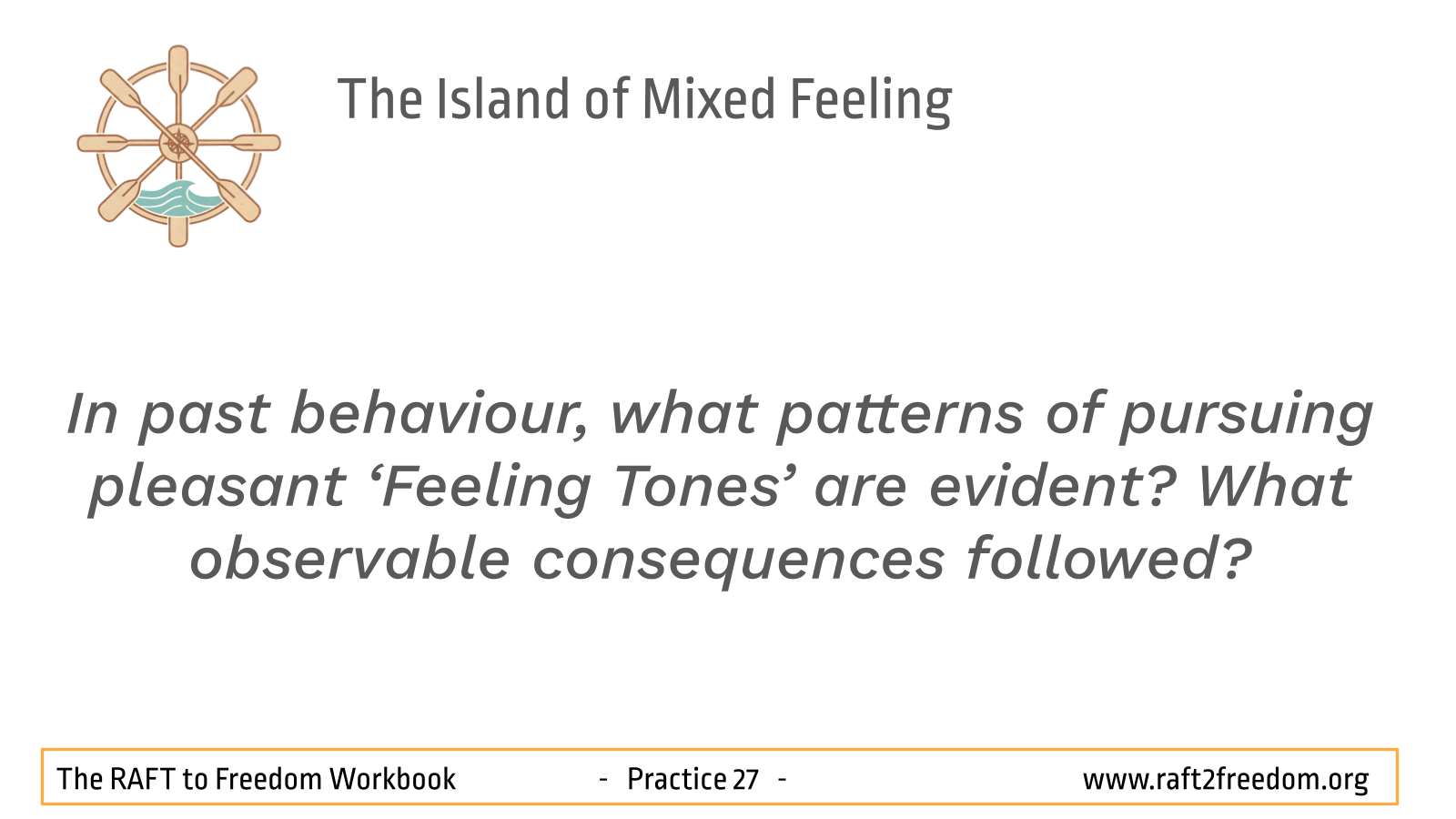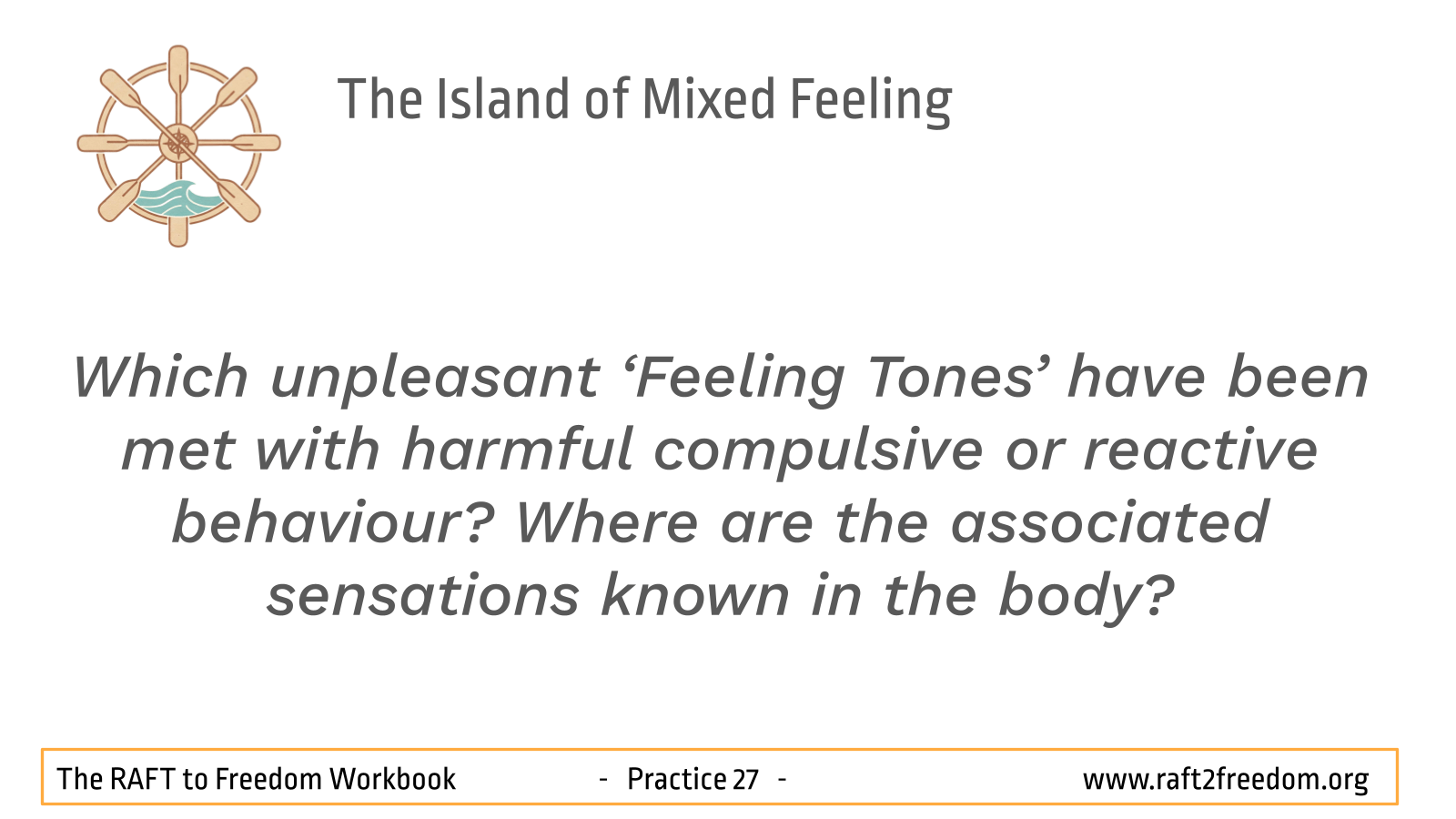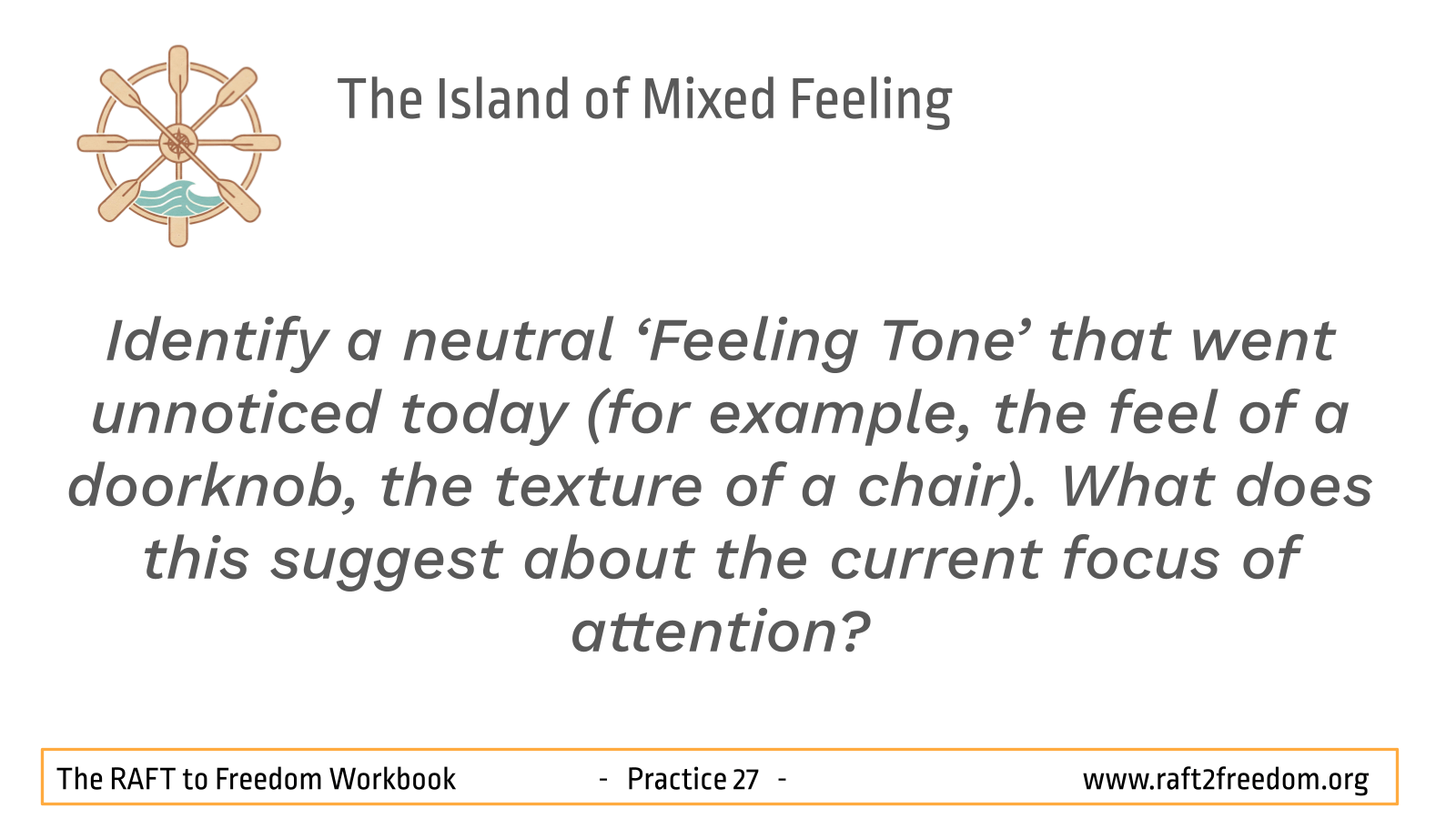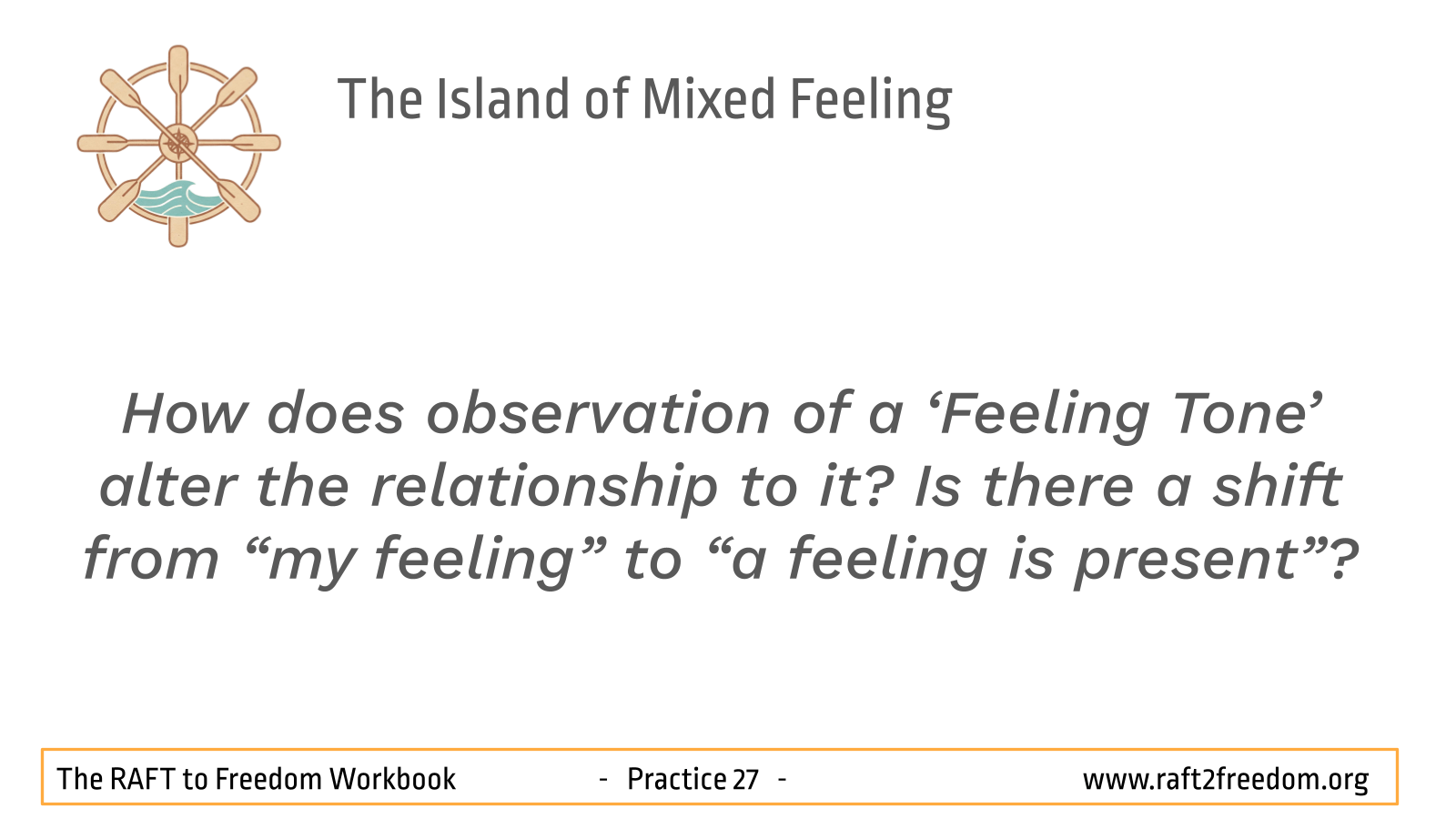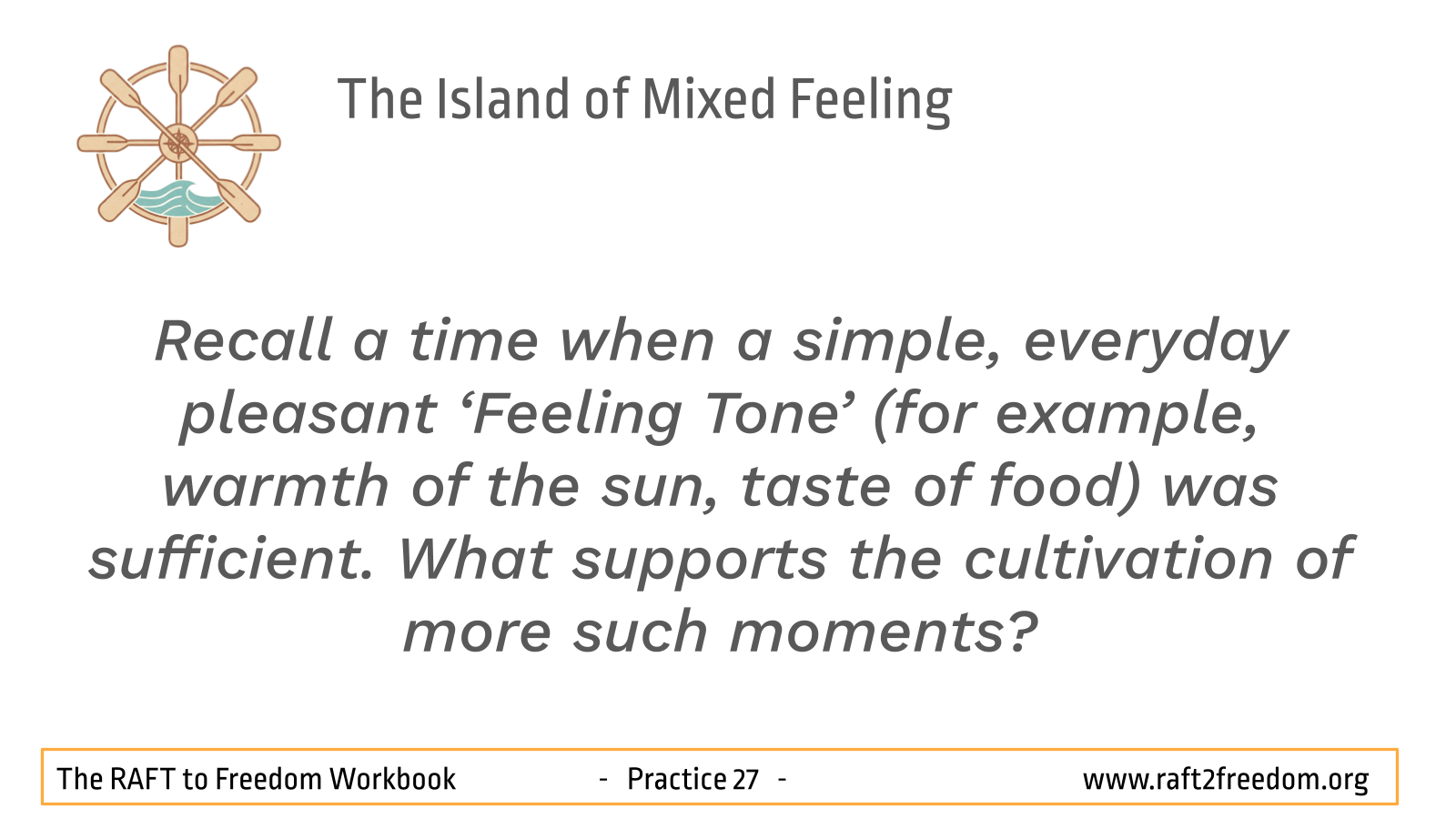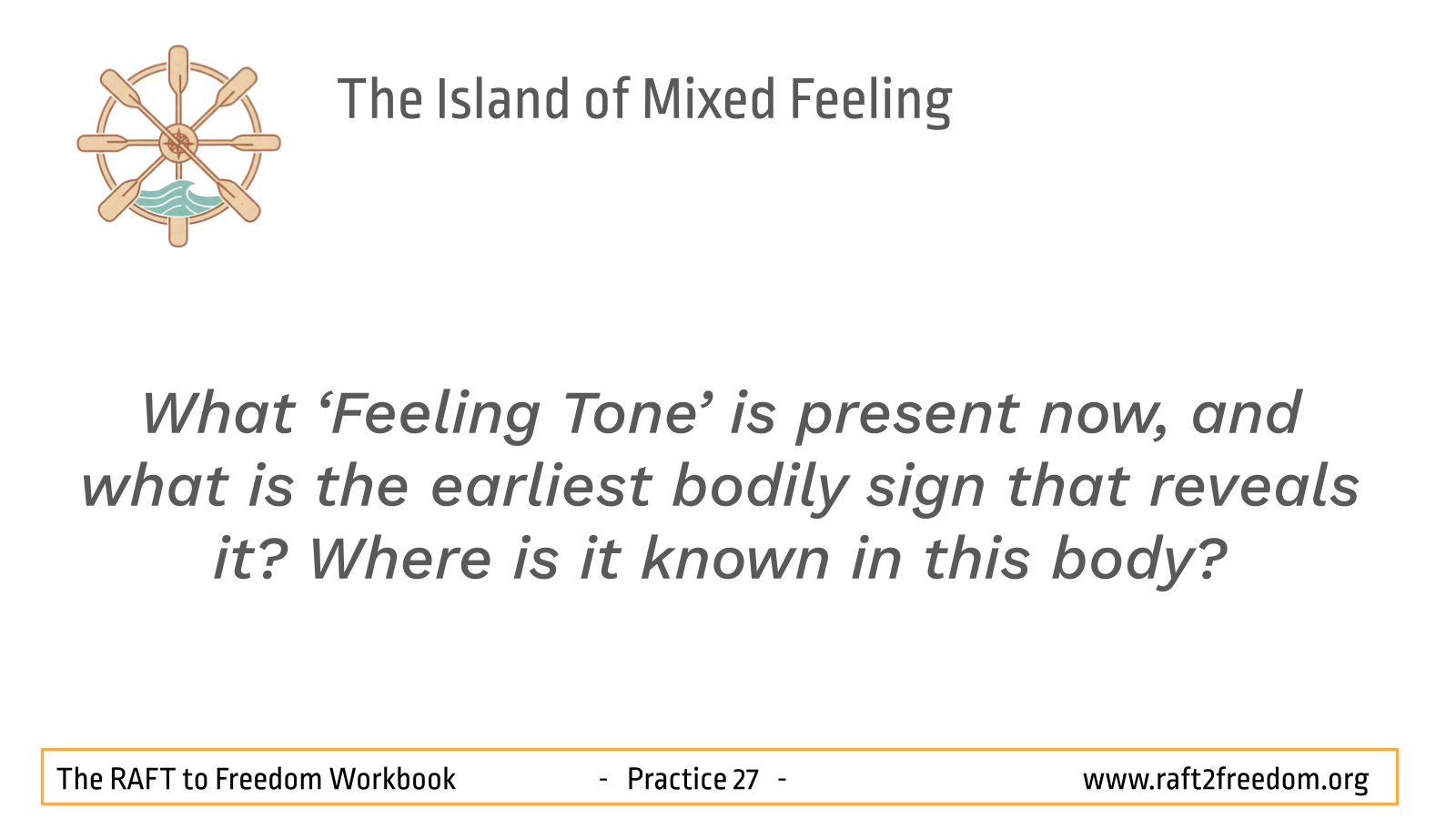The second Anchor of Mindfulness –Reading the subtle currents around our raft
The second Anchor of Mindfulness – feeling the way to freedom
Tuning into raw experience
Feeling is one of those mental factors… every conscious experience has a feeling-tone, pleasant, painful or neutral.
Ven. Nyanaponika Thera
The cure for the pain is in the pain.
Rumi

Episode 27: The second Anchor of Mindfulness – feeling the way to freedom
An AI generated ‘deep dive’ into this aspect of the RAFT to Freedom
Having cultivated the essential heart quality of ‘Befriending’ (Metta) to support us on the second stage of the journey – (‘A’ – Abandoning), we now turn to the second ‘Anchor of Mindfulness’ – Mindfulness of ‘Feeling Tone’ (vedana) – a mindfulness practice for understanding and interrupting the cycle of craving.
Affect is the general sense of feeling that you experience throughout each day. … The first – valence – is how pleasant or unpleasant you feel. … The second – arousal – is how calm or agitated you feel.
Lisa Feldman Barrett
‘Feeling tone’ refers to the bare, immediate ‘affective’ quality of an experience, arising the instant there is contact through the senses (including the mind). It is the simple, pre-verbal quality of pleasant, unpleasant, or neutral. This feeling tone arises before complex emotions, stories, judgments, or conscious thoughts take shape. Every conscious experience is accompanied by one of these three feeling tones. Gotama (the Buddha) describes the practice simply:
“… when a practitioner is feeling a pleasant feeling, they understand ‘I am feeling a pleasant feeling’. When a practitioner is feeling an unpleasant feeling, they understand ‘I am feeling an unpleasant feeling. When a practitioner is feeling a neutral feeling, they understand ‘I am feeling a neutral feeling’”.
Gotama also distinguishes between bodily and mental feeling tones, which helps us to see, for instance, how a bodily ache can be met without adding mental distress, or how mental anticipation can be pleasant even before anything touches the body.
When are ‘feelings’ not ‘feelings’
Lots of people find the concept of ‘Mindfulness of Feelings’ very confusing – equating ‘Feelings’ as emotions. But ‘vedana’ is more subtle than simple emotions. In this chapter and workbook, ‘Mindfulness of Feelings’ means ‘feeling tones’ – the immediate pleasant, unpleasant, or neutral ‘flavour’ that accompanies every physical and mental experience (including thoughts and memories). Feeling tone is not the raw sensation (like warmth or pressure) and not the emotion (like anger or joy). It’s the quick, simple tone that often shows up first.
Why is paying attention to this subtle level so critical for abandoning patterns of escape and self-sabotage? Because feeling tone is a pivotal link in the chain of ‘Dependent Origination’. Dependent Origination is the way Gotama described the chain of causes that keeps suffering going. Each link naturally gives rise to the next. When the senses come into contact with something – a sight, sound, thought, or experience – a feeling tone arises: pleasant, unpleasant, or neutral. If this feeling tone is not recognised clearly, it easily leads to craving – wanting more of the pleasant or pushing away the unpleasant. Craving then grows into clinging, the tightening around ‘I want this’ or ‘I don’t want this’. From clinging, suffering unfolds in many forms. Because feeling tone is a pivotal link in this chain, learning to observe it with awareness interrupts this cycle and opens the way to freedom.
Typically, a pleasant feeling tone triggers craving for more of it, leading to attachment and eventual disappointment when it fades. An unpleasant feeling tone typically triggers aversion (a pulling away from what is experienced, or a desire for it to cease), leading to resistance, struggle, and often conditioned behaviours that limit freedom. A neutral feeling tone is often overlooked, leading to boredom, restlessness, or a subtle undercurrent of dissatisfaction that can fuel ‘seeking behaviour’ or dullness (ignorance). The human struggle with craving and avoidance can be understood as the mind’s perpetual, automatic reaction to feeling tones. Individuals are constantly driven by the desire to pursue pleasant feeling tones, to avoid unpleasant feeling tones, and to escape the boredom or dullness of neutral feeling tones. This is the very definition of craving, that amplifies the inherent pains, difficulties and disappointments of life, and creates vast amounts of unnecessary, avoidable suffering.
The practice of observing feeling tones is more than just a technique for managing urges; it is a direct path to profound insight. By watching a feeling tone as it arises, intensifies, and eventually fades, we gain a direct, personal verification of the truth of impermanence (anicca). The feeling is seen not as a solid, permanent state, but as a fleeting, wave-like event. In this seeing, its power to command a reaction diminishes. Similarly, as our awareness stays with the raw sensation, it becomes clear that this is simply ‘a feeling arising’ or ‘unpleasantness being known‘ rather than ‘my pain’. This shift in perspective is a direct experience of not-self (anattā). It loosens the grip of the ego’s identification with the feeling, revealing that these experiences are impersonal, conditioned processes. It is this direct insight, not willpower, that ultimately cuts the root of craving and clinging.
Gotama’s two arrows
A powerful image for this appears in the ‘Two Arrows’ teaching. The first arrow is unavoidable pain (an unpleasant tone); the second arrow is the added reactivity – resentment, self-pity, fantasy pursuit of relief – which multiplies the suffering. ‘Mindfulness of Feeling Tone’ trains an individual to feel the first arrow cleanly and refrain from firing the second, thus reducing suffering without denial. Over time, it can be learned that feeling tones change on their own when we don’t contract around them.
“The uninstructed practitioner feels a painful feeling. Touched by that painful feeling, he sorrows, grieves, and laments; he weeps, beating his breast, and becomes distraught. He feels two feelings – a bodily one and a mental one.
The well-instructed practitioner… feels the painful feeling, but does not sorrow, grieve, or lament. He feels only one feeling: a bodily one, not a mental one.” ~ Gotama
By bringing mindful awareness directly to feeling tone as it arises, the opportunity to interrupt this chain reaction at its root is gained. The raw feeling tone is seen before the habitual reaction of craving or aversion fully takes hold, which creates a space for choice, allowing for a creative and wise response rather than a compulsive one (trigger awareness). If the experiences that precede habitual behaviours are known, the momentum of the habitual mind can be broken. This practice requires the kindness and non-judgment cultivated through ‘Befriending’ – by meeting these raw tones without immediate preference or rejection. This fundamental shift in mental habit pattern changes feeling tones from a cause of bondage to a means of liberation.
“We can choose not to suffer for our preferences”
Gotama’s distinction between bodily and mental feeling tones is a tool of profound practical value. Consider the experience of chronic physical pain. The initial sensation is an unpleasant bodily feeling tone – this is the first arrow. Often, an immediate secondary reaction occurs: a cascade of unpleasant mental feeling tones such as fear (‘this will never end‘), frustration (‘I can’t stand this’), or despair. These mental reactions are the second arrow, which multiplies the suffering. ‘Mindfulness of Feeling Tone’ trains us to separate these two. It becomes possible to acknowledge the unpleasant bodily sensation with compassionate awareness, without adding the layer of mental distress. The physical ache can be met as it is, while the mind remains steady and unburdened, preventing the spiral of suffering that so often fuels the search for escape.
The raft’s barometer
In the ‘RAFT to Freedom’ metaphor, feeling tones are like the subtle shifts in the water’s current or the first hints of changing weather immediately impacting our raft. Pleasant breezes might tempt us to drift carelessly towards pleasurable illusions. Unpleasant choppy waves might provoke fear and create a desire to fight the water or abandon ship. Periods of neutral calm might lull us into inattention. ‘Mindfulness of Feeling Tone’ is like developing a sensitive barometer or learning to feel the subtle movements of the water against the hull. It allows for reading the immediate conditions accurately and navigating skillfully before strong winds or dangerous currents (craving and aversion) fully develop and threaten to take control of our raft. This awareness of feeling tones becomes a powerful anchor, providing stability and direction on our journey to liberation.
Practical guidance: navigating the currents of feeling
When strong urges or painful emotions arise, they can feel like a sudden storm threatening to capsize the raft. Navigating these waters skillfully requires a two-stage approach: first, surviving the peak of the storm, and second, learning from the currents once the winds have calmed.
Stage 1: First aid for stormy seas – surviving the peak of the urge
When an urge feels overwhelming, the immediate priority is to stay on the raft without acting in harmful ways. Direct observation may not be possible at this point. Instead, the focus is on creating a brief space. This can be achieved through skillful distraction and self-soothing, tools adapted from modern therapeutic practices like Dialectical Behavior Therapy (DBT). Consider these options:
- Activities: Engage in a healthy, absorbing activity for a few minutes. This could be listening to loud music, doing a few strenuous exercises, or solving a simple puzzle. The aim is to briefly shift the focus of attention away from the intensity of the urge.
- Contributing: Shift attention outward by doing a small, helpful act for someone else. This could be sending a supportive text, doing a household chore, or helping a colleague.
- Sensations: Use intense, non-harmful physical sensations to interrupt the urge. This could involve holding an ice cube in the hand, taking a very cold shower, or biting into a lemon. The shock of the sensation can break the momentum of the habitual mind.
- Self-soothing: Engage the five senses in a gentle, comforting way. Light a scented candle (smell), listen to calming music (hearing), wrap in a soft blanket (touch), look at a beautiful image (sight), or sip a warm, non-alcoholic drink (taste).
Stage 2: Reading the currents – mindful observation and urge surfing
- Surfing: As the initial peak of the urge subsides, a space opens for the deeper practice of ‘Healing Mindfulness’ (chapter 31). This is the practice of ‘urge surfing‘ – observing the remaining energy of the urge as it moves through the body-mind without being swept away by it.
- Find a steady anchor: Begin the practice by sitting comfortably and bringing attention to the present moment. Focus on the physical sensations of the breath as an initial anchor to calm the mind and body. Notice the urge as it affects the body: Gently scan the body and locate where the urge is felt most distinctly as a physical sensation. Is it a tightness in the chest? A hollowness in the stomach? A tingling in the hands? Focus the awareness on the raw physical qualities of this sensation. Notice the gentle rise and fall of the abdomen or the cool sensation of air entering and leaving the nostrils.
- Name the tone, not the tale: Lightly note the immediate feeling tone – pleasant, unpleasant, or neutral – and let the label be enough for a few breaths. Notice the mind’s tendency to lean (grasping, pushing, drifting) without obeying it. This trains recognition at the earliest moment of choice.
- Gently scan the body: After a few minutes of focusing on the breath, gently shift awareness through the body (as in a body scan we explored earlier in the workbook). Systematically scan from the top of the head down to the toes, or simply focus on an area of neutral sensation, like the palms of the hands. The objective is to notice any physical sensations, whether gross (for example, pressure, warmth) or subtle (for example, tingling).
- Investigate the sensation: Without judgment, note its characteristics. Is it warm or cool? Is it vibrating, pulsing, or still? Does it have clear borders, or is it diffuse? Observe how these qualities shift from moment to moment, breath by breath. This is not about analysing the feeling, but about experiencing its direct, physical reality without the tale.
- Acknowledge the feeling tone: As a sensation is noticed, gently and non-judgmentally acknowledge its hedonic tone. Is it pleasant, unpleasant, or neutral? There is no need to create a story about the feeling, just a simple mental note, such as ‘pleasant,’ ‘unpleasant,’ or ‘neutral’. This is the gut feeling of the sensation, a quick read-out without further thought.
- Run a three-pass scan: Sweep for unpleasant (acknowledge, allow), then pleasant (enjoy without clinging), then neutral (discover stability rather than drift). This builds confidence that tones shift on their own when met early.
- Differentiate body and mind: Name whether the tone is bodily (ache, pressure, warmth) or mental (unease, anticipatory brightening). Untangling these reduces confusion – common in cycles of becoming driven by craving.
- Observe Impermanence: Hold the sensation in awareness, observing its fleeting and conditioned nature. Notice how it is not solid or permanent but is constantly changing – arising and passing away, much like a wave in the ocean. This is the essence of ‘urge surfing,’ where an experience is ‘ridden like a wave’ until it naturally subsides, rather than giving in to it.
- Use MARA (chapter 14): When urges surge, pause and ask: “What’s the tone now?”. Take three steady breaths with a befriending phrase, then choose one compassionate/kind next step away from harm. This practice aligns with M.A.R.A. (Mindful Awareness Responds Appropriately) – a skillful response rather than a habitual reaction.
- Return to the anchor: If the sensation becomes overwhelming or if the mind begins to generate a story about it, gently and compassionately return attention to the sensation of the breath or another safe anchor. The practice is not about fighting or suppressing feelings, but about training the mind to observe them with non-reactive awareness.
Self-reflections
Use these self-reflection questions to notice feeling tone early and remain independent, not clinging.
- In past behaviour, what patterns of pursuing pleasant ‘Feeling Tones’ are evident? What observable consequences followed?
- Which unpleasant ‘Feeling Tones’ have been met with harmful compulsive or reactive behaviour? Where are the associated sensations known in the body?
- When craving is present, what underlying ‘Feeling Tone’ is discernible – pleasant anticipation, unpleasant restlessness, or another quality?
- Identify a neutral ‘Feeling Tone’ that went unnoticed today (for example, the feel of a doorknob, the texture of a chair). What does this suggest about the current focus of attention?
- How does observation of a ‘Feeling Tone’ alter the relationship to it? Is there a shift from “my feeling” to “a feeling is present”?
- What new, skilful means for cultivating wholesome, pleasant ‘Feeling Tones’ are you cultivating?
- Recall a time when a simple, everyday pleasant ‘Feeling Tone’ (for example, warmth of the sun, taste of food) was sufficient. What supports the cultivation of more such moments?
- What ‘Feeling Tone’ is present now, and what is the earliest bodily sign that reveals it? Where is it known in this body?
- When a pleasant ‘Feeling Tone’ is present, what grasping tendencies are noticed? With an unpleasant tone, what pushing or escape tendencies begin? With a neutral tone, is drift or steadiness apparent?
- Track the arising, peaking, and passing of a strong ‘Feeling Tone’. How long before it changes on its own when it is simply known?
- Which ‘Feeling Tone’ most often precedes unhelpful choices? What single kind next step most reliably moves you away from harm when that tone is present?
Journaling prompts
The following prompts invite deeper personal engagement and connect the practice of ‘Mindfulness of Feeling Tones’ to the lived experience on the path of healing. Keep entries brief, regular, and try impersonal phrasing (for example, ‘a tightness is being noticed’).
- Investigating disconnecting habits: From a place of compassionate awareness, what could you write about the habit patterns that lead to disconnection? What might the pleasant and unpleasant ‘Feeling Tones’ that fuel these habits reveal if given a voice?
- Exploring an unpleasant sensation: Describe a moment this week when a strong unpleasant sensation (for example, tension, anxiety) was present. Journal about how it was known in the body, what thoughts arose, and how behaviour unfolded without turning to patterned reactions.
- Mindful eating: With one chosen food, explore pleasant ‘Feeling Tones’ using all the senses. How does this experience differ from eating without awareness?
- Weather report: Record an inner ‘weather report’ today by naming ‘Feeling Tones’ as clouds, rain, sunshine, or fog. How is this weather being observed without the attempt to change it?
- Gratitude / Happiness: Recall a moment of gratitude or genuine happiness this week. Journal about the bodily qualities of this pleasant ‘Feeling Tone’, and note how it differs from a ‘high’ or fleeting pleasure.
- Goodbye letter – setting a new resolve: What words may be offered to the old pattern of aversion toward unpleasant ‘Feeling Tones’? What new skilful intention arises to take its place?
- ‘Feeling-Tone’ Log (60 minutes): Every few minutes, record the dominant ‘Feeling Tone’ and the cue that preceded it. Add one sentence on how the tone shifted (or did not shift). What patterns are evident by the end of the hour?
- Neutrality: Consider one neutral moment. Did this moment turn into a restful moment or did you drift into craving or aversion? Note the context and what allowed neutrality to become rest rather than drift (or vice versa). Conclude with one sentence on using neutrality as a quiet refuge.
- Body versus mind diary: For two stressful events, record the bodily tone (ache, pressure, heat) and the mental tone (unease, tight anticipation). Did seeing them separately reduce reactivity?
- Ninety-second wave: During a strong ‘Feeling Tone’, time the span from first noticing to first easing while breathing steadily. What phrase or posture supported steadiness (for example, ‘steady here,’ ‘I see you, Māra’)? How might this be repeated?
Supporting material: scientific and philosophical perspectives
For those interested in the scientific and philosophical underpinnings of ‘Mindfulness of Feeling Tone’, the following overview highlights some key connections.
- Neuroscience: Modern neuroscience illuminates the precise brain mechanism through which Mindfulness of Feeling Tones helps to dismantle harmful compulsive patterns. These patterns are often driven by a hyper-reactive ‘bottom-up’ reward circuit, centered in the limbic system (including the amygdala and nucleus accumbens), which generates powerful cravings. This is coupled with a weakened ‘top-down’ control network in the prefrontal cortex (PFC), which is responsible for executive functions like impulse control and wise decision-making. The practice of observing feeling tones directly targets and remodels this dysfunctional circuitry. When an urge arises, instead of automatically reacting, the practice activates the insula, a critical brain region for interoception – the sensing of internal bodily states. By focusing on the raw physical sensations of the craving, the insula’s activity is brought into conscious awareness. This act of mindful observation strengthens functional connectivity between the PFC and the amygdala, creating a crucial ‘pause’ between stimulus and response. This pause allows the PFC to regulate the limbic impulse, rather than be hijacked by it.
Simple pleasant and unpleasant feelings come from an ongoing process inside you called interoception.
Lisa Feldman Barrett
Furthermore, research has shown that mindfulness-based interventions can restore the brain’s natural reward system. Addiction often leads to anhedonia, a blunting of the ability to experience pleasure from everyday events. Mindfulness practices have been shown to increase the brain’s response to natural, healthy rewards – a process known as ‘savouring’ – which directly correlates with reduced cravings and improved emotional well-being. In essence, the practice retrains the brain to find satisfaction in wholesome experiences, weakening the pull of destructive habits.
- Psychology: From a psychological perspective, ‘Mindfulness of Feeling Tones’ is a core skill for developing emotional regulation and distress tolerance. Many patterns of escape and self-sabotage are maladaptive attempts to avoid or control uncomfortable internal experiences. This practice offers a radically different and more effective strategy: ‘acceptance’. It is the foundational skill at the heart of several powerful, evidence-based psychotherapies. In Acceptance and Commitment Therapy (ACT), this practice is central to the core processes of acceptance (allowing feelings to be present without struggle) and ‘cognitive defusion’ (seeing thoughts and feelings as transient events, not literal truths that must be acted upon). By observing a feeling tone as just a feeling tone, one learns to detach from the compelling ‘story’ it usually brings with it.
In Dialectical Behavior Therapy (DBT), a treatment designed to help individuals manage overwhelming emotions, this practice is a cornerstone of ‘distress tolerance’ skills. The technique of ‘urge surfing,’ which is explicitly taught in this chapter, is a direct application of mindfulness to the intense cravings that can precede relapse. It involves viewing an urge not as a command, but as a wave of energy and sensation that can be mindfully ‘surfed’ as it rises, crests, and inevitably subsides on its own. This builds profound self-efficacy, demonstrating directly that one does not have to be a victim of one’s urges. The Buddhist psychological archetype of the ‘Hungry Ghost’ (preta) serves as a powerful metaphor for the state that this practice heals: the ghost’s insatiable hunger and pinhole throat perfectly capture the futility of trying to find lasting satisfaction by feeding cravings.
- Philosophy: The practice of observing feeling tones is deeply rooted in the core philosophical insights of Buddhism, primarily the doctrines of Impermanence (anicca) and Not-Self (anattā). These are not abstract beliefs but truths to be verified through direct experience, and Mindfulness of Vedanā (Feeling Tone) is a primary vehicle for this verification. As one observes any feeling – pleasant, unpleasant, or neutral – it becomes undeniably clear that it is in constant flux; it arises, changes, and passes away. This direct seeing of impermanence dismantles the illusion that any feeling state is solid or permanent, which in turn weakens the urge to cling to the pleasant or resist the unpleasant. Even more profoundly, the practice deconstructs the illusion of a fixed, permanent ‘Self’ who is the owner of the experience. By observing a feeling simply as a conditioned mental event, the deep-seated identification “this is my feeling” begins to dissolve into the more accurate perception “there is a feeling present“. This depersonalisation is the heart of the insight into ‘not-self’. It reduces the ‘hedonic investment’ in the experience, making it easier to let go of the reactivity, self-criticism, and shame that often accompany difficult feelings.
This approach finds resonance in Western philosophy as well; the Stoics, for example, trained themselves to observe their initial ‘impressions’ (phantasiai) of events without immediately giving ‘assent’ to the judgments and emotions that would typically follow, creating a similar space for wise and virtuous response.
Remember to remember
Our raft is sailing toward freedom, but the waters are often choppy, filled with the storms of pleasant cravings and unpleasant aversions. Without a strong anchor, we can easily be tossed back into the destructive currents of habitual patterns. This chapter has shown that the most powerful anchor one possesses is one’s own awareness of ‘Feeling Tone’ – the simple, bare feeling tones of pleasant, unpleasant, and neutral. By learning to observe and name these fleeting sensations without judgment or automatic reaction, a vital space is created between the feeling and the impulse to act.
Remember to remember that we are not our feelings. We are the ‘one’ who can observe them. Each time a feeling is noticed and the choice is made not to be driven by it, the anchor is strengthened. The old habit of craving is replaced with the new habit of wisdom. This is not about fighting feelings; it is about ‘Befriending’ them. It is in this simple, gentle act of awareness that we find the true power to steer our raft with purpose and compassion, forging a path to lasting freedom. Feeling tones are signals, not commands. This anchor steadies our raft for the ‘Five Defenders’ that follow this chapter.
If things go wrong, don’t go with them.
Proverb
An emotion is your brain’s creation of what your bodily sensations mean, in relation to what is going on around you in the world.
Lisa Feldman Barrett
Sutta References
- Satipaṭṭhāna Sutta (MN 10) – The Foundations of Mindfulness
- Summary: This foundational discourse outlines the four domains of mindfulness. In the section on Vedanānupassanā (Contemplation of Feeling), it gives precise instructions for observing pleasant, unpleasant, and neutral Feeling Tones, distinguishing between worldly (sāmisa) and spiritual (nirāmisa) experiences. This sutta provides the direct “how-to” manual for contemplating Feeling Tones as they arise and pass away, forming the unshakable basis of Healing Mindfulness.
- Summary: This foundational discourse outlines the four domains of mindfulness. In the section on Vedanānupassanā (Contemplation of Feeling), it gives precise instructions for observing pleasant, unpleasant, and neutral Feeling Tones, distinguishing between worldly (sāmisa) and spiritual (nirāmisa) experiences. This sutta provides the direct “how-to” manual for contemplating Feeling Tones as they arise and pass away, forming the unshakable basis of Healing Mindfulness.
- Pahāna Sutta (SN 36.3) – Giving Up
- Summary: Gotama explains that abandoning underlying tendencies (anusaya)—such as lust for pleasant feelings and aversion toward unpleasant ones—requires understanding three aspects of feelings: gratification (assāda), danger (ādīnava), and escape (nissaraṇa). This discourse provides the strategic “why” behind the practice. Freedom does not come from eliminating feelings but from wisely seeing their seduction, their unreliability, and the liberation found in non-attachment.
- Summary: Gotama explains that abandoning underlying tendencies (anusaya)—such as lust for pleasant feelings and aversion toward unpleasant ones—requires understanding three aspects of feelings: gratification (assāda), danger (ādīnava), and escape (nissaraṇa). This discourse provides the strategic “why” behind the practice. Freedom does not come from eliminating feelings but from wisely seeing their seduction, their unreliability, and the liberation found in non-attachment.
- Datthabba Sutta (SN 36.5) – To Be Known
- Summary: This teaching differentiates between carnal (sāmisa) feelings linked to sensual pleasures and spiritual (nirāmisa) feelings linked to renunciation and meditative absorption. It encourages cultivating the latter. The sutta clarifies that not all pleasant feelings are equal. It guides the practitioner to cultivate wholesome spiritual happiness, such as the joy of generosity or the calm of a quiet mind, rather than the fleeting pleasures of old conditioned behaviours.
- Gelañña Sutta (SN 36.7) – The Sick Ward
- Summary: While visiting a sick ward, Gotama uses the metaphor of different winds—dusty, clean, hot, and cold—to describe the many types of feelings. He emphasises that all are transient, natural, and impersonal. This discourse reinforces the principle of anattā (not-self) in relation to feelings. By likening them to “weather patterns” moving through the body-mind system, it offers a powerful tool for depersonalising experience and reducing reactivity.
RAFT to Freedom © 2025 by Dr Cathryn Jacob and Vince Cullen is licensed under CC BY-NC-SA 4.0. To view a copy of this license, visit https://creativecommons.org/licenses/by-nc-sa/4.0/ |
